
Contents





Architect Who Seeks to Transform Life






Two Years of Welcome
Teaching English and Cultural Engagement
I find myself surprised by my allegiance to Korea, often scolding travelers I meet for not scheduling enough time on their itinerary here. While I love the festivals and the food, ultimately I’m most grateful for the Korean people who have welcomed and taught me here.
Written & photographed by Leeann Oelrich, Fulbright English Teaching Assistant
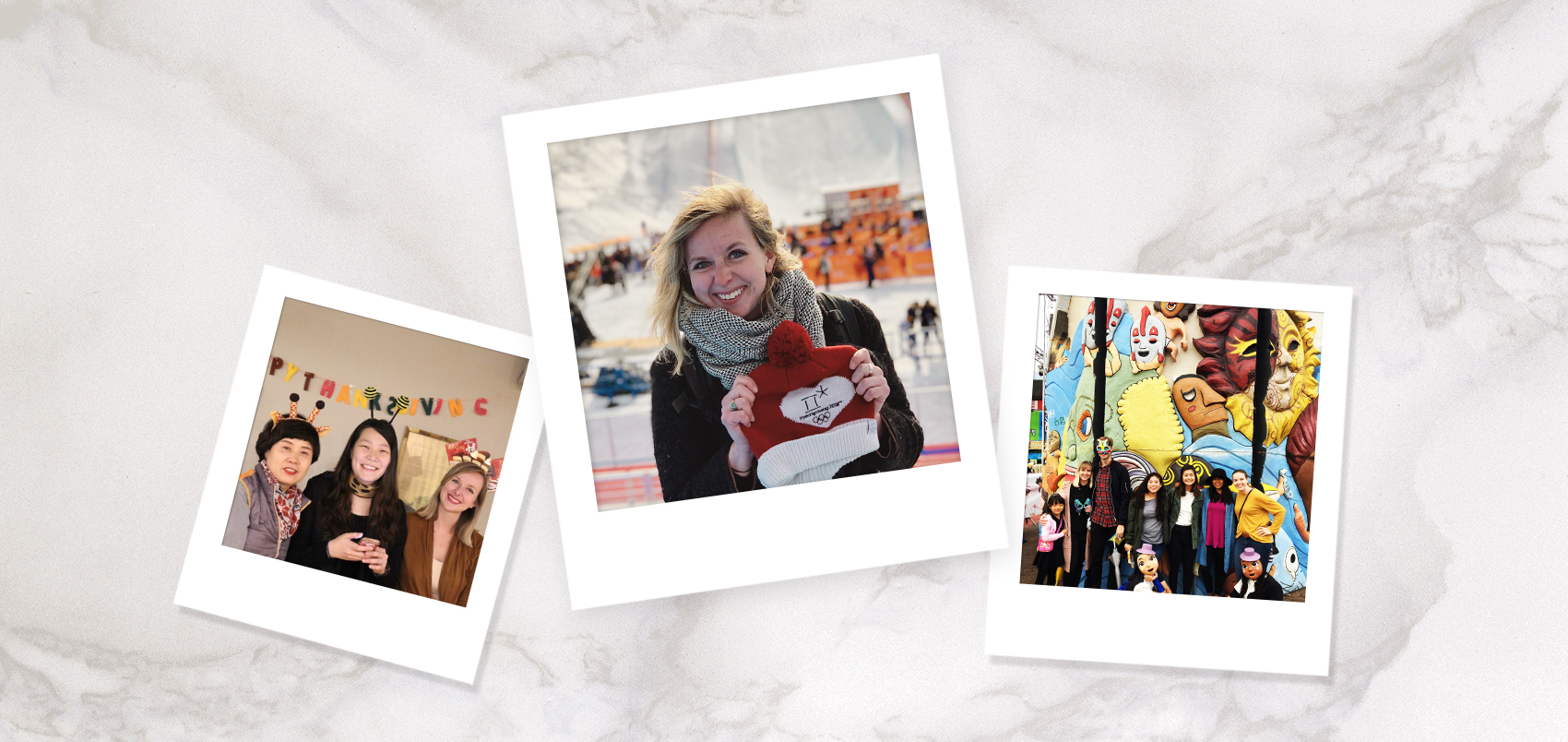
Coming to Korea
I came to Korea to work as a Fulbright English Teaching Assistant. I started learning about Korea because of my interest in human rights and reunification of the Korean Peninsula. The Fulbright Program, sponsored by the U.S. State Department, allows recent college graduates to teach English in selected countries and engage in cultural exchange.
After six weeks of Fulbright’s indepth orientation, it was time to move to our prospective placements and begin our work. I was placed in Andong, Gyeongsangbuk-do Province, a small city of about 160,000 nestled in the mountains. It’s known for showcasing the traditional way of life through folk museums and villages, a mask festival and its speciality: Andong soju (the Korean liquor of choice). I moved in with a Korean host family and began teaching at a competitive private boarding high school.
Traditional Life and Education in Andong
Living with a Korean family in the conservative center of the nation confirmed many archetypes of Korean culture, especially surrounding the rigorous education system. During my second week of classes, I gave my students an assignment to write letters to their future selves, and everybody wrote about “surviving” school life. My students were incredibly dedicated to their studies, and most had a high intermediate to advanced level of English. Many planned to apply to top Korean universities and already had specific career aspirations in mind.
While the atmosphere was focused and intense, I was absolutely captivated by the teacher-student relationship in Korea and the family-like atmosphere. Teachers and students were attentive to the needs of those around them, and this was so apparent in and out of the classroom. Synchronized eating in the cafeteria, constantly showing affectionate physical contact, noticing if any one of their peers was too hot, or too cold, or upset. Despite being under immense pressure to perform, my students constantly demonstrated thoughtfulness and kindness. I used my class to breathe some lightheartedness and mental health awareness into their very structured, heavily focused lives—and received this warmth and attentiveness in return.
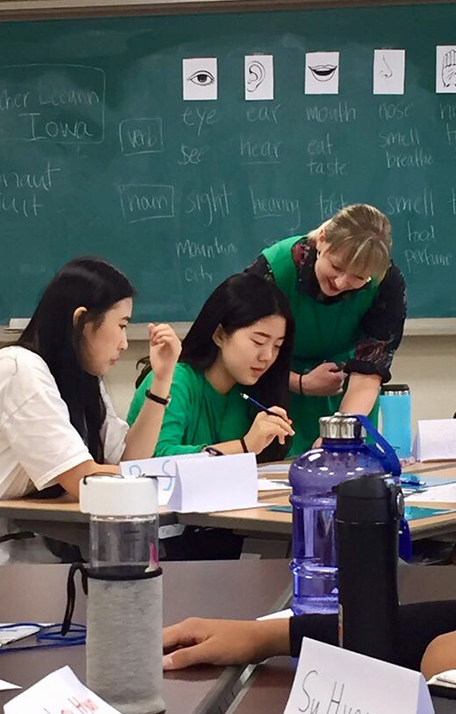 Leeann Oelrich’s first English class in Korea
Leeann Oelrich’s first English class in Korea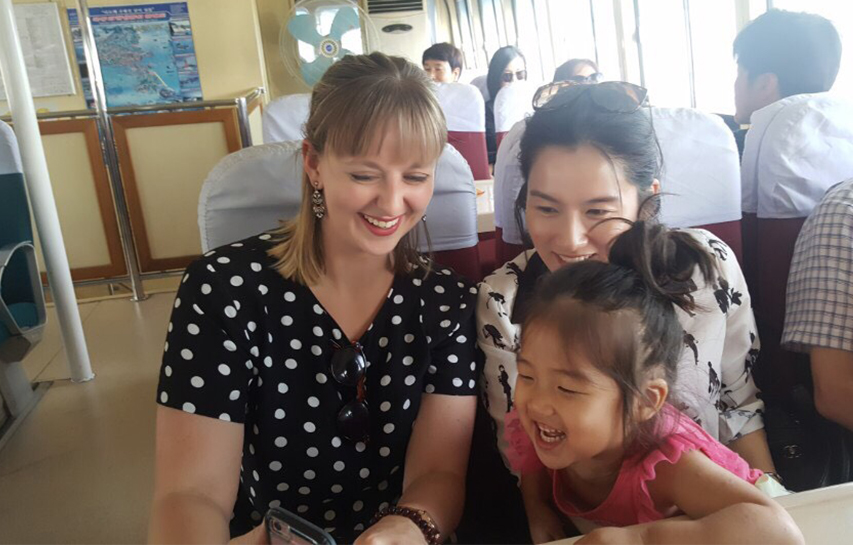 On a cruise with Leeann Oelrich’s host family in Yeosu
On a cruise with Leeann Oelrich’s host family in YeosuThis combination of intensity and warmth continued into my evenings with my host family. My host family was large by modern Korean standards, composed of my host father (a surgeon), my host mother (a stay-at-home mom) and four kids all under the age of ten. The house was full of energy: loud, chaotic and cheerful. While my host parents spoke English, my host siblings did not, and each day brought practice in non-verbal communication. We would muddle through our life together in “Konglish” and charades. Sometimes negotiations: my facial cleanser is not meant for bubble baths, the kimchi should stay on the table and not all over my new shirt. But it was always punctuated by moments of sweetness: walking into my room to deliver little snacks, climbing up into my lap at dinner or coming up with Korean nicknames for me.
The parents and I also found time during the busy week to connect; they’d often knock on my door at 11 p.m. (or later) to ask if I was awake. I’d open it to find them whispering like teenagers sneaking out, asking if I wanted to have chicken and beer. We sat cross-legged at the kitchen table, gorging ourselves on chicken and beer, and chatting in our pajamas about Korean reunification and health care politics, whatever antics their kids were up to and stories from our past travels. Ultimately, living with such a large host family truly anchored me in the community and I was never lonely for long.
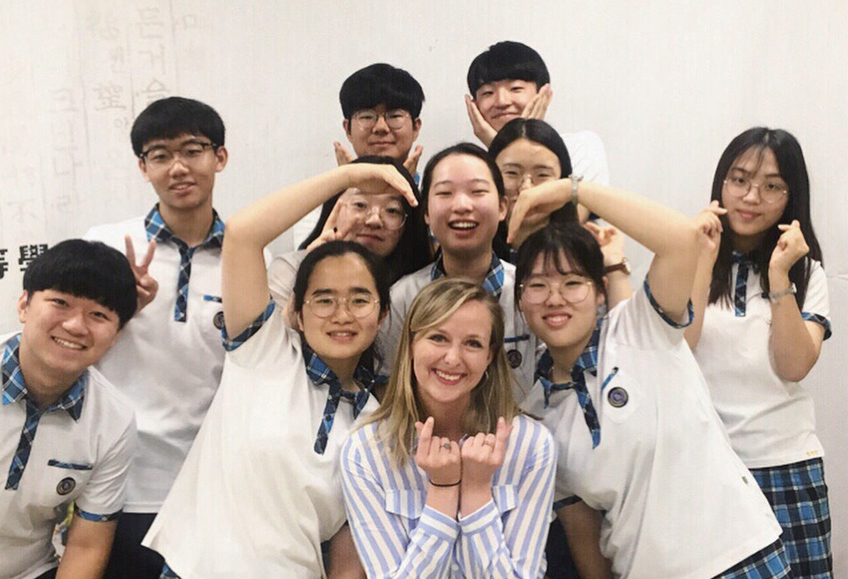 After a poetry event with some of Leeann’s former students in Andong
After a poetry event with some of Leeann’s former students in AndongTraveling in Korea
On weekends, I traveled around Korea to learn about and take part in the country’s rich traditions and festival culture. Everywhere I went, I was invited to spaces and experiences by Koreans who were proud and eager to share them with me. The list of moments like this is long but a few I hold especially dear.
In late summer, I went to Seoraksan National Park. The hike was both 100 percent uphill and 100 percent worth the effort. The trails were steep but I was rewarded at every few landings of stairs with a view of the river or the next peak over. Huffing and puffing, I was passed constantly by Korean ajumma (Korean middle-aged women) and ajeossi (Korean middle-aged men) who arrived by the vanload in their matching hiking gear. We climbed to the peak together, stopping to fan each other every so often, and reached the summit to watch the clouds around the cascade.
October brought Chuseok (Full Moon Harvest), one of Korea’s two major holidays. I went to my host mother-inlaws house, and was immediately swept up into the frantic preparations. Despite only knowing each other a few months, I was welcomed and expected to join in. Due to my lack of cooking expertise, I was delegated to the same tasks as the kids. We sat on the floor kneading dough and peeling pine needles to make songpyeon, traditional rice cake sweets stuffed with sugar and nuts. While my relationship with the family so far had been hesitant and introductory, our time preparing the traditional meal equalized us and deepened our friendship. This was solidified when the youngest child, 2 years old, toddled up to me wanting some attention. Tugging on my leg, he said my name for the first time in front of the whole family.
 This picture was taken on Leeann’s language class graduation day with her RAs and the professor.
This picture was taken on Leeann’s language class graduation day with her RAs and the professor.As the weather grew colder, I began to frequent the jjimjilbang (public sauna). Often the only foreigner in the room, I felt insecure about my presence there. Stripped naked in a maze of lockers, my cluelessness felt a little more vulnerable than usual. My insecurity faded quickly as a grandmother sensed my confusion and pantomimed me through the correct etiquette. As I soaked in the heated pools, I stuck my tongue out at the little girls who were staring at me curiously. It was enough of an invitation for them to approach, and they played with my hair while their mothers chased their younger siblings around the showers. Suddenly, I was a part of this feminine camaraderie, and I reveled in all kinds of bodies and ages taking care of themselves and caring for each other.
Interactions like these were brief and seemingly trivial, but shaped so much of my experience and are some of my fondest memories in Korea.
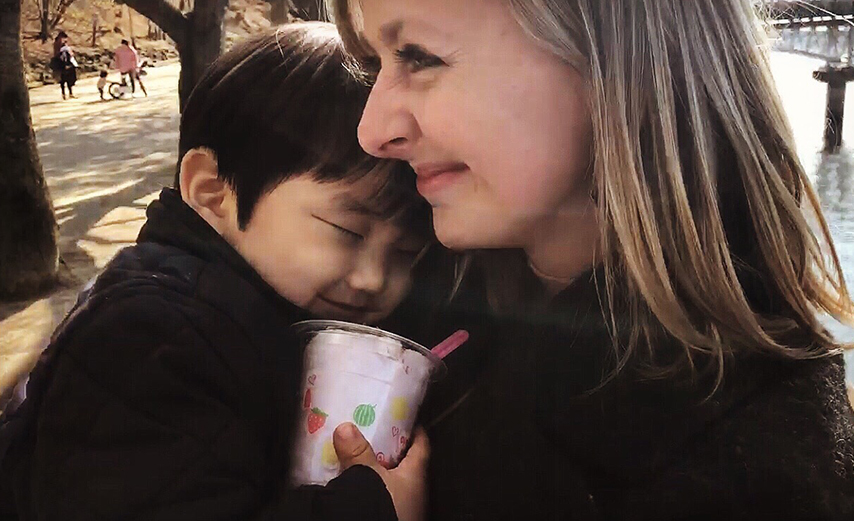 Enjoying spring weather at Woryeonggyo Bridge in Andong with her host brother
Enjoying spring weather at Woryeonggyo Bridge in Andong with her host brother Her host sister is tightly holding Leeann’s hand and posing.
Her host sister is tightly holding Leeann’s hand and posing.Second Year, Second City
After a year living in Andong and exploring the country, I decided to spend a second year in Korea. I wanted to experience Korea more independently, and spend more time learning about North Korea and reunification. I now teach at an alternative school that serves North Korean students in Busan, South Korea’s bustling second city. My second year here is drastically different than the first, much of which stems from the structure of my new school. My new school is structured entirely to fit the needs of our special student population. A third of the students are North Korean defectors, a third are children of North Korean defectors (many of whom grew up in China), and a third are South Korean students with special interest in preparing for the reunification of the Korean Peninsula. The school aims to close the achievement gap (North Korean students drop out at four times the rate of their South Korean counterparts) while building leadership and global citizenship skills—ultimately modeling and preparing for the possibility of a reunified Korea.
While my first year showed me traditional ideas about Korean education, my new school is teaching me about alternative approaches to schooling and what it means to be Korean. The school is small enough to accommodate the vastly different needs of its students and takes a much more holistic approach. Many of the students will not take the college entrance exam, thus sparing them the constant pressure of the test looming over their heads. In addition to academics, students are encouraged to develop leadership skills, service and empathy for others and dreams for their own future and a reunified Korea. The students I work with are consistently among the brightest and most resilient individuals I’ve encountered, and I learn from them constantly.
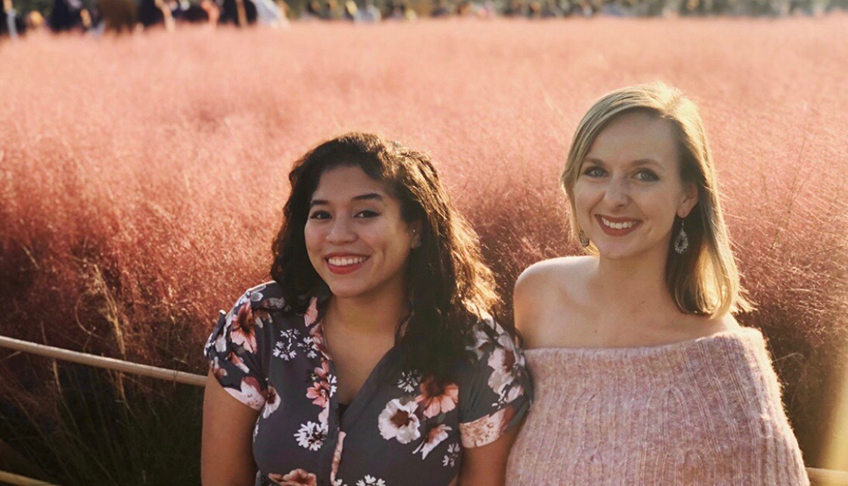 Leeann Oelrich visits the Pink Muhly Grass in Gyeongju with her friend.
Leeann Oelrich visits the Pink Muhly Grass in Gyeongju with her friend.Beyond Korea
Although I’ve been here for a year and a half, Korea continues to challenge and surprise me. My time here has made me a warmer person: more generous and perceptive to those around me. I’ve learned o be flexible and open to new experiences, to be a gracious host and guest, to put my head down and work hard, and to engage with a culture so fundamentally different from my own. While I’m not sure where the next year will take me, I’m grateful to carry these lessons and values along the way.
Korea & I features contributions from non-Korean, reflecting the opinions of the writers as faithfully as possible. Thus the opinions expressed therein may differ from the opinions of the editors of <KOREA> magazine.
Other Articles





Architect Who Seeks to Transform Life





Application of subscription
Sign upReaders’ Comments
GoThe event winners
Go


 January 2019
January 2019


